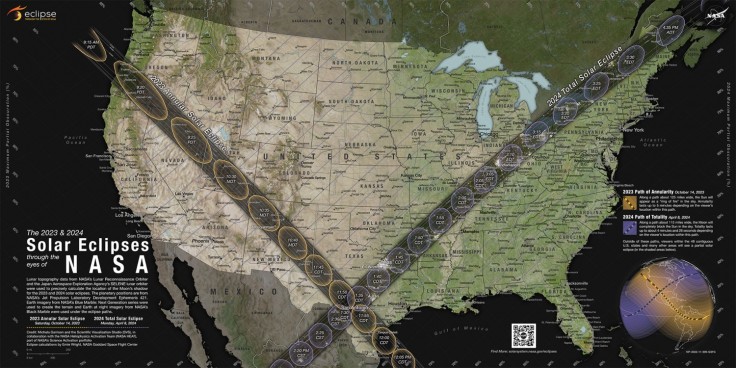Finding the perfect place to watch solar eclipses for 2023 and 2024 is now easier to do.
NASA recently released a map that details where the best spots are to watch the solar eclipses scattered through 2023 and 2024, providing skywatchers a means to prepare for a specific solar eclipse ahead of time.
People interested in the space agency's new map can download a copy for themselves at NASA's Scientific Visualization Studio.
NASA Solar Eclipse Map Details

NASA mentioned that the solar eclipse map it created is based on observations from several unspecified NASA missions, with it detailing the path of the moon's shadow as it goes across the contiguous US during the annular solar eclipse or "ring of fire" solar eclipse on Oct. 14, 2023, and the total solar eclipse on Apr. 8, 2024.
According to Space.com, Michala Garrison, a member of NASA's Goodard Space Flight Center's Scientific Visualization Studio (SVS), designed a map using their background in geography and cartography. According to Garrison, the map's goal is to inspire people to view the eclipses and ensure they have access to details of annular and total eclipses.
For those unaware, an annular solar eclipse happens when the moon appears smaller in front of the sun, causing the latter's outer edge to form a ring of fire around the moon. Meanwhile, a total solar eclipse happens when the moon completely blocks out the sun; people can see the sun's ghostly-white corona during this type of eclipse.
The dark areas shown in the map represent the moon's shadow as it crosses the US; inside these dark zones are yellow ovals and dark circles representing the Oct. 14 annular eclipse and the Apr. 8, 2024, total solar eclipse, respectively.
The places within the yellow ovals are the best places to see the annular solar eclipse, while the area within the dark circles is the places ideal to see total solar eclipses. The shapes also include a time stamp that represents the time viewers in these locations will see the eclipse, allowing people to better prepare their equipment beforehand to watch these celestial events as it happens.
The intersection point, located in an area of Texas near San Antonio, is the best place to see both the annular and total solar eclipse.
Those within the dark zone but not inside any of the shapes will still see the solar eclipse, though not as spectacularly as those within them. Meanwhile, those outside the dark zone may see a partial eclipse instead of an annular or total solar eclipse.
How To Safely Watch An Eclipse
To watch a solar eclipse, people need to remember to never look at the sun directly while the eclipse is happening without wearing protective eyewear. Doing so will allow your eyes to concentrate on the sun's light and focus it on a minute spot on the retina, which is the back of your eye.
This simple act will burn your eyes, causing either permanent eye damage or blindness, per Exploratorium. You won't even know your eyes are burning from the inside because there have no pain sensors.
This damage happens because the light from the sun is more intense during a solar eclipse than when it is not, according to Arpansa. Expect larger amounts of infrared radiation, ultraviolet radiation, and excessive visible light, especially blue light, during a solar eclipse.
If you wish to watch the eclipse without looking directly at it, you may want to try the methods we recommended for the April 30, 2022 solar eclipse.
Related Article : Asteroid 2023 DW Will Almost Certainly Miss Earth in 2046, NASA Claims









